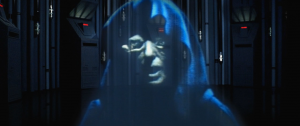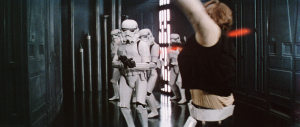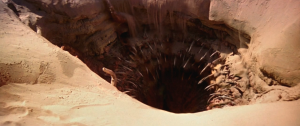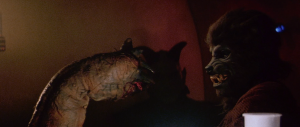Perhaps the Special Editions have been too harshly attacked by fans of the un-altered, theatrical cuts of Star Wars. Alternatively, perhaps there is something to be criticised in their role in effectively banishing the original 1977, 1980, and 1983 versions of these films to the ether.
Ever since the 1997 Special Edition versions of the original Star Wars trilogy were released, the validity, merits, flaws, and worth of these controversial incarnations have been debated. Many fans have made genuine (and reasonable) arguments as to their qualities. Ian McDiarmid’s insertion into the Emperor’s holographic appearance in The Empire Strikes Back is an understandable alteration. It solidifies the film’s links to both Return of the Jedi and Revenge of the Sith (McDiarmid having portrayed Emperor Palpatine in both of those respective films).

Just as amiable is the newly-added Hoth Wampa footage also in The Empire Strikes Back. Demonstrating a clear consideration for visual continuity, the Wampa in the new footage is still an impressive, practical man-in-suit creation – a welcome departure from the modus operandi of the Special Editions, where most changes were in the form of extensive CGI replacements.
Perhaps some elements of the Special Editions have been treated unfairly by fans adamant about the quality of the original, theatrical cuts. Because of this, it is important to remain as objective as possible – hence the praise for the changes mentioned above.
On the other hand, perhaps such resistance to the changes of the Special Editions isn’t totally unreasonable either. Steven Sloss, of the Kaijusaurus Podcast, has spoken of the positive diversity that alternate cuts of films can add. In his and co-host Ross Menzies’ episode wherein they tackle 1984’s The Return of Godzilla, Steven points out that having alternate cuts of a single film can not only improve its accessibility, but provides multiple ways in which a narrative can be enjoyed. The issue with the Special Editions, however, is that since their 1997 release they have instead acted as replacements.
Bar a mediocre release of the theatrical cuts on DVD in 2006 (these releases were sourced from an early ’90s laserdisc, were non-anamorphic, and suffered from motion-smearing), the un-altered versions of these films have never seen the light of quality home-video distribution. The only versions commercially available on DVD, Blu-Ray, or to download are the Special Editions. Rumours continue to circle online about the possibility of a release of the theatrical cuts, but as of August 2017, nothing has come to pass. The closest we have come is with such fan restoration projects as Harmy’s Star Wars: Despecialized Edition and Team Negative 1’s Star Wars: Silver Screen Edition. These projects (of mammoth proportion) are fan-produced high-definition restorations of the theatrical cuts, pulling from sources as far reaching as VHS copies to 35mm scans. Not only fantastic in quality, they illustrate the palpable desire for the original versions of these films to receive an official release.

Of course, the question as to why it hasn’t happened usually leads back to the fact that with Disney now owning Lucasfilm, but 20th Century Fox still retaining rights to the original trilogy, there are associated legal difficulties that may come with such an attempt. Update as of May 2020: Disney+ now has the original trilogy to stream. However, these versions are still the truncated Special Editions.
So what does that make this article? A heartfelt but ultimately useless plea to see the original, un-altered cuts released? A monologue criticising each and every Special Edition alteration?
For too long, the discussion surrounding the original incarnations of Star Wars has essentially been usurped by an argument of ‘which is better?’ Fans of the theatrical cuts will point out the poorly-aging CGI changes, or the damage that changes have inflicted on the saga (the inclusion of Vader shouting ‘no’ in Return of the Jedi was a clear mistake) whilst fans of the Special Editions tend to argue (reasonably so) the merits of the changes.
Such an argument is not conducive of any positive outcome, though. One group of fans will inevitably be left unsatisfied whenever yet another ‘ARE THE SPECIAL EDITIONS REALLY THAT BAD?’ video hits the internet.
It’s important that we re-frame the narrative of this discussion. Instead of comparing the two versions of these iconic films, it’s more important that we address why the original, theatrical cuts are important to begin with.
As much as George Lucas may wish that the Special Editions were the only versions that will ever be seen again, his wishes are ultimately detrimental to culture and artistic integrity as a whole. Whether one prefers the Special Editions or not, one must realise that those theatrical versions changed cinema. It was the un-altered incarnations of Star Wars that swept the Academy Awards, not the Special Editions. The theatrical cuts featured phenomenal practical special effects whilst the newly-added CGI of the Special Editions was far from revolutionary even in 1997. The Special Editions may be the only versions commercially available, but their cultural value pales in comparison to what came before them.

The desire to alter one’s artistic vision to the point where it is closest to one’s intentions is understandable (and a position that can be respected). However, to alter and then deny what came before is irresponsible when these films have such an important cultural standing. Let’s say historians had found a document wherein Shakespeare bemoaned the ending of King Lear and had wished it was changed. Let’s also say that dramatists and publishers then changed the ending in all further productions and prints to fit with Shakespeare’s wishes. There would be public outcry from those who appreciated it in its original format, and who opposed seeing this alternative ending replace it.
This is not to compare Star Wars to the works of Shakespeare, but to point out that changing and then totally replacing a piece of such artistic importance is harmful to culture itself. It robs generations of experiencing how these films were presented upon release. It arguably says that ownership and responsibility of one’s work is not important when one can change and then deny the original.
The Special Editions have earned their place by virtue of a large portion of the Star Wars fan-base who admire and enjoy them, but that does not (nor should it) devalue the un-altered versions of these films. Right now, there is a growing number of fans tired of being stuck with only one way of watching this influential saga, and a number of parents eager to show their children the magic of that galaxy far, far away just as they first saw it – whether on VHS or actually in the cinema in 1977, 1980, or 1983. The original, un-altered, theatrical cuts of Star Wars, The Empire Strikes Back, and Return of the Jedi deserve their respect and admiration. They don’t deserve to be cast aside for the sake of achieving one man’s admittedly flawed original intentions.
An appreciation of the original cuts of these films is important – for culture, for future generations, and for artistic integrity.
Perhaps this article has turned into a plea for the originals to be released, but maybe that isn’t entirely bad after all. I’m sure that Lak Sivrak, the wolf man in the Mos Eisely cantina (who was removed by the Special Editions), would agree.

* This article’s feature image is of the original, un-altered version of Star Wars (1977). Frame taken from Team Negative 1’s Silver Screen Restoration.

